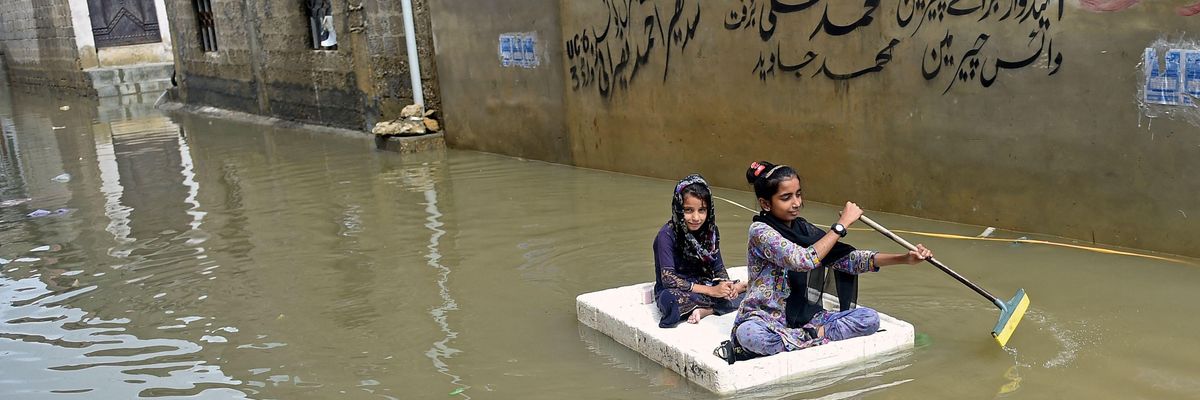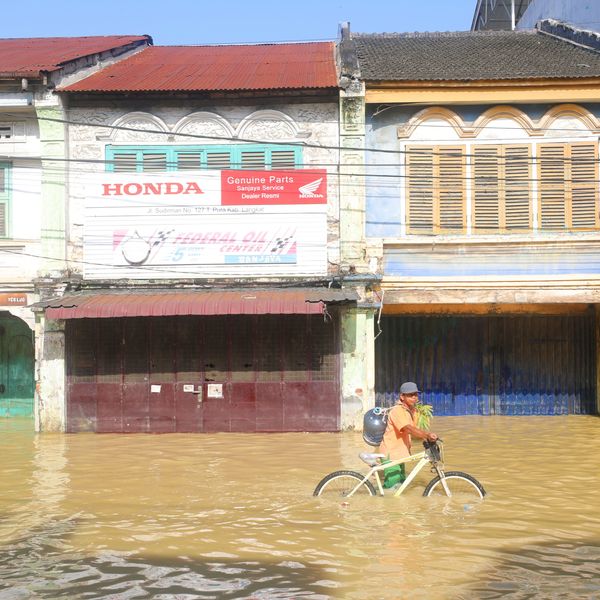
Girls use a temporary raft across a flooded street in a residential area after heavy monsoon rains in Karachi on July 26, 2022. A weather emergency was declared in Karachi as heavier-than-usual monsoon rains continue to lash Pakistan's biggest city, flooding homes and making streets impassable.
CO2 Levels Are the Highest in a Million Years as Extreme Weather and Flooding Rage Across the Globe
We can change all this, but we have to hurry to shut down CO2 emissions quickly.
CNN reports that satellite photos show that the overflowing Indus has created a new body of water in southern Pakistan some 62 miles (100km) wide. It will take days or weeks for the water to recede, and in the meantime millions are left homeless and over all, 33 million people have been affected by the worst monsoon floods in recorded history. CNN quotes Pakistan's Climate Minister Sherry Rahman as saying "That parts of the country 'resemble a small ocean,' and that 'by the time this is over, we could well have one-quarter or one-third of Pakistan under water.'"
Because of our burning of fossil fuels to drive cars and heat and cool buildings, the world is heating up. But the Indian Ocean is heating up a third faster than the rest of the world. Very warm waters in the Bay of Bengal are helping create more destructive cyclones and flooding. The air over warming waters contains more moisture than the 20th century average. Warming waters also make the winds that blow over them more erratic, and wayward winds from the Arabian Sea helped push the heavy monsoon rains farther north than they usually extend.
We don't have to look far for the culprits. J. Blunden, and T. Boyer, Eds., 2022: "State of the Climate in 2021" Bull. Amer. Meteor. Soc., 103 (8), Si-S465, https://doi.org/10.1175/2022BAMSStateoftheClimate provides a state of the climate report for 2021.
It isn't good news. The concentration in the atmosphere of carbon dioxide increased another 2.6 parts per million, to a year-long average of 414.7 parts per million of CO2. We should be trying to get to zero increases of carbon dioxide, not increasing it. Arctic snow cores show that there hasn't been that must CO2 in the atmosphere for at least 800,000 years, i.e. nearly a million years. It turns out that if you go back to "1 million Years B.C." you don't find Raquel Welch, you find a steaming tropics of a world. The growth rate for methane was the highest on record. Methane is 25 times more potent than carbon dioxide as a heat-trapping gas, and CO2 isn't any slouch itself. Methane, though, dissipates quickly if you don't keep adding to it in the stratosphere, in as little as nine years. If you put carbon dioxide up there, though, it can last thousands and thousands of years. It is gradually absorbed by the oceans or igneous rocks, but he ocean may reach its capacity for absorption of CO2 in only 15 years, after which the stuff will just stay up there, making earth hot.
The report says that Death Valley, California, reached 54.4degC (130.46 F.) for the second time since records have been kept. Across the global ice concentrations or "cryosphere," glaciers lost ice mass for the 34th consecutive year. Now the BBC is predicting that in the near future the glacier ice lost will become so great that it will threaten the water supplies of Switzerland and other European countries.
And in horrific news for Bangladesh and Egypt, the report says, "Across the world's oceans, global mean sea level was record high for the 10th consecutive year, reaching 97.0 mm above the 1993 average when satellite measurements began, an increase of 4.9 mm over 2020."
Seas rising, carbon dioxide concentrations in the atmosphere rising to best a million-year-old-record, super-monsoons. We can change all this, but we have to hurry to shut down CO2 emissions quickly.
An Urgent Message From Our Co-Founder
Dear Common Dreams reader, The U.S. is on a fast track to authoritarianism like nothing I've ever seen. Meanwhile, corporate news outlets are utterly capitulating to Trump, twisting their coverage to avoid drawing his ire while lining up to stuff cash in his pockets. That's why I believe that Common Dreams is doing the best and most consequential reporting that we've ever done. Our small but mighty team is a progressive reporting powerhouse, covering the news every day that the corporate media never will. Our mission has always been simple: To inform. To inspire. And to ignite change for the common good. Now here's the key piece that I want all our readers to understand: None of this would be possible without your financial support. That's not just some fundraising cliche. It's the absolute and literal truth. We don't accept corporate advertising and never will. We don't have a paywall because we don't think people should be blocked from critical news based on their ability to pay. Everything we do is funded by the donations of readers like you. Will you donate now to help power the nonprofit, independent reporting of Common Dreams? Thank you for being a vital member of our community. Together, we can keep independent journalism alive when it’s needed most. - Craig Brown, Co-founder |
CNN reports that satellite photos show that the overflowing Indus has created a new body of water in southern Pakistan some 62 miles (100km) wide. It will take days or weeks for the water to recede, and in the meantime millions are left homeless and over all, 33 million people have been affected by the worst monsoon floods in recorded history. CNN quotes Pakistan's Climate Minister Sherry Rahman as saying "That parts of the country 'resemble a small ocean,' and that 'by the time this is over, we could well have one-quarter or one-third of Pakistan under water.'"
Because of our burning of fossil fuels to drive cars and heat and cool buildings, the world is heating up. But the Indian Ocean is heating up a third faster than the rest of the world. Very warm waters in the Bay of Bengal are helping create more destructive cyclones and flooding. The air over warming waters contains more moisture than the 20th century average. Warming waters also make the winds that blow over them more erratic, and wayward winds from the Arabian Sea helped push the heavy monsoon rains farther north than they usually extend.
We don't have to look far for the culprits. J. Blunden, and T. Boyer, Eds., 2022: "State of the Climate in 2021" Bull. Amer. Meteor. Soc., 103 (8), Si-S465, https://doi.org/10.1175/2022BAMSStateoftheClimate provides a state of the climate report for 2021.
It isn't good news. The concentration in the atmosphere of carbon dioxide increased another 2.6 parts per million, to a year-long average of 414.7 parts per million of CO2. We should be trying to get to zero increases of carbon dioxide, not increasing it. Arctic snow cores show that there hasn't been that must CO2 in the atmosphere for at least 800,000 years, i.e. nearly a million years. It turns out that if you go back to "1 million Years B.C." you don't find Raquel Welch, you find a steaming tropics of a world. The growth rate for methane was the highest on record. Methane is 25 times more potent than carbon dioxide as a heat-trapping gas, and CO2 isn't any slouch itself. Methane, though, dissipates quickly if you don't keep adding to it in the stratosphere, in as little as nine years. If you put carbon dioxide up there, though, it can last thousands and thousands of years. It is gradually absorbed by the oceans or igneous rocks, but he ocean may reach its capacity for absorption of CO2 in only 15 years, after which the stuff will just stay up there, making earth hot.
The report says that Death Valley, California, reached 54.4degC (130.46 F.) for the second time since records have been kept. Across the global ice concentrations or "cryosphere," glaciers lost ice mass for the 34th consecutive year. Now the BBC is predicting that in the near future the glacier ice lost will become so great that it will threaten the water supplies of Switzerland and other European countries.
And in horrific news for Bangladesh and Egypt, the report says, "Across the world's oceans, global mean sea level was record high for the 10th consecutive year, reaching 97.0 mm above the 1993 average when satellite measurements began, an increase of 4.9 mm over 2020."
Seas rising, carbon dioxide concentrations in the atmosphere rising to best a million-year-old-record, super-monsoons. We can change all this, but we have to hurry to shut down CO2 emissions quickly.
CNN reports that satellite photos show that the overflowing Indus has created a new body of water in southern Pakistan some 62 miles (100km) wide. It will take days or weeks for the water to recede, and in the meantime millions are left homeless and over all, 33 million people have been affected by the worst monsoon floods in recorded history. CNN quotes Pakistan's Climate Minister Sherry Rahman as saying "That parts of the country 'resemble a small ocean,' and that 'by the time this is over, we could well have one-quarter or one-third of Pakistan under water.'"
Because of our burning of fossil fuels to drive cars and heat and cool buildings, the world is heating up. But the Indian Ocean is heating up a third faster than the rest of the world. Very warm waters in the Bay of Bengal are helping create more destructive cyclones and flooding. The air over warming waters contains more moisture than the 20th century average. Warming waters also make the winds that blow over them more erratic, and wayward winds from the Arabian Sea helped push the heavy monsoon rains farther north than they usually extend.
We don't have to look far for the culprits. J. Blunden, and T. Boyer, Eds., 2022: "State of the Climate in 2021" Bull. Amer. Meteor. Soc., 103 (8), Si-S465, https://doi.org/10.1175/2022BAMSStateoftheClimate provides a state of the climate report for 2021.
It isn't good news. The concentration in the atmosphere of carbon dioxide increased another 2.6 parts per million, to a year-long average of 414.7 parts per million of CO2. We should be trying to get to zero increases of carbon dioxide, not increasing it. Arctic snow cores show that there hasn't been that must CO2 in the atmosphere for at least 800,000 years, i.e. nearly a million years. It turns out that if you go back to "1 million Years B.C." you don't find Raquel Welch, you find a steaming tropics of a world. The growth rate for methane was the highest on record. Methane is 25 times more potent than carbon dioxide as a heat-trapping gas, and CO2 isn't any slouch itself. Methane, though, dissipates quickly if you don't keep adding to it in the stratosphere, in as little as nine years. If you put carbon dioxide up there, though, it can last thousands and thousands of years. It is gradually absorbed by the oceans or igneous rocks, but he ocean may reach its capacity for absorption of CO2 in only 15 years, after which the stuff will just stay up there, making earth hot.
The report says that Death Valley, California, reached 54.4degC (130.46 F.) for the second time since records have been kept. Across the global ice concentrations or "cryosphere," glaciers lost ice mass for the 34th consecutive year. Now the BBC is predicting that in the near future the glacier ice lost will become so great that it will threaten the water supplies of Switzerland and other European countries.
And in horrific news for Bangladesh and Egypt, the report says, "Across the world's oceans, global mean sea level was record high for the 10th consecutive year, reaching 97.0 mm above the 1993 average when satellite measurements began, an increase of 4.9 mm over 2020."
Seas rising, carbon dioxide concentrations in the atmosphere rising to best a million-year-old-record, super-monsoons. We can change all this, but we have to hurry to shut down CO2 emissions quickly.

